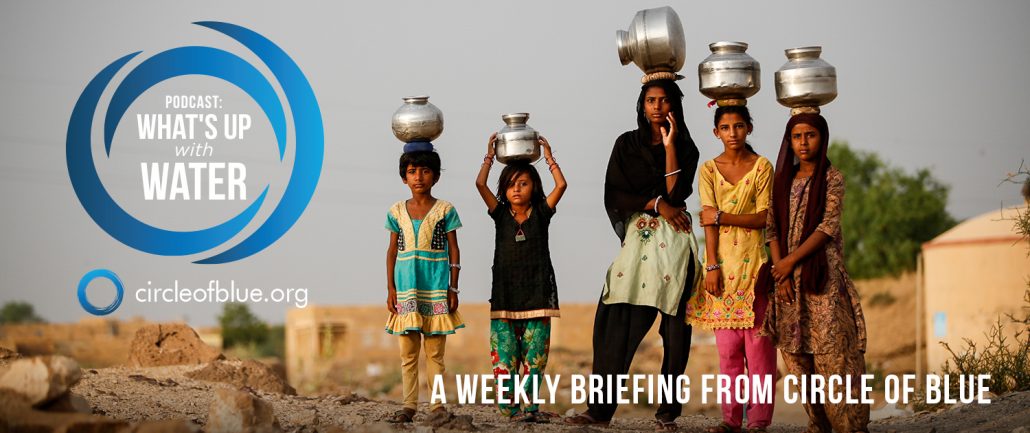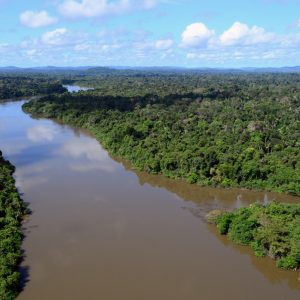
Transcripts
What’s Up With Water for August 6, 2018
I’m Eileen Wray-McCann, for Circle of Blue, and here’s What’s Up with Water, your “need-to-know news” of the world’s water.
In Southeast Asia, Myanmar is in the thick of a deadly monsoon season. Severe rains contributed to at least 12 deaths, and tens of thousands of people are displaced by flooding. Among the dead are three soldiers swept away by rushing floodwaters during a rescue operation.
Heavy rains continue to obstruct efforts to help nearly 30 thousand people who remain in flooded homes. Roughly 150 thousand people are sheltering in temporary camps.
Last week’s floods afflicted southern, eastern and central Myanmar, closing highways, demolishing bridges, and submerging thousands of acres of farmland.
Parts of Myanmar flood each year during the peak of monsoon, causing landslides and hammering agriculture and infrastructure. The United Nations says it is following this year’s situation with great concern, and mobilizing its partners, resources and capacity to provide support.
Authorities have urged people to abandon low-lying areas, and to err on the side of caution when thinking about waiting out the rains at home. The Myanmar Red Cross Society has been picking up the stranded in small boats, but it is limited by both conditions and capacity.
——————–
In India, the megacity of Kolkata, formerly known as Calcutta, is grappling with increasingly intense weather. That means more frequent storms, cyclones, water disturbances, flooding and heat spells.
In 2014, the Intergovernmental Panel on Climate Change predicted a trend in climate extremes, It named Kolkata, a delta city of 14 million people near the mouth of the Ganges, as one of the urban centers vulnerable to climate risk. The river and nearby wetlands used to protect the city from monsoons by channeling floodwater into the Bay of Bengal. But today many of these natural drainage systems are silted up or displaced by ever-expanding construction projects.
Other forces are at work, too. Unsustainable demands on groundwater are depressing the land while water levels in the Bay of Bengal rise faster than the global average. The imbalance forces salt water into agricultural land, displacing farmers who move to the city to earn a living. There they find the stress of poverty and the effects of flooding: paralyzed communities, backed-up drains, contaminated tap water and diseases such as Dengue fever.
Extreme rainfall has become more common in a city that is already vulnerable to floods. And it is more harmful in a place where nearly a third of the population lives in slums, or is altogether without shelter. The Organization for Economic Cooperation and Development warns that if greenhouse gasses continue as expected, in about 50 years Kolkata will likely have more people exposed to coastal flooding than any city in the world.
Last month, the heat index, which factors temperature plus humidity, rose to 45 degrees Celsius, or 113 degrees Fahrenheit.
A native of Kolkata, the environmental journalist Jayanta Basu, told the New York Times “On one side your threat is increasing and you are basically in a prehistoric level of preparedness,” he said, “All in all, you’re in for a disaster.”
In U.S. news, Michigan’s Lieutenant Governor Brian Calley declared a state of emergency for Kalamazoo County after high levels of PFAS chemicals were discovered in drinking water.
On July 26, testing revealed that a municipal water system had PFAS chemicals at levels more than 20 times higher than a U.S. Environmental Protection Agency health advisory. The system serves about 3 thousand residents in Parchment and Cooper Township.
PFAS are a group of chemicals that were once common in fire-fighting foam, nonstick surfaces, stain guard and other commercial and industrial applications. They are worrisome because they remain in the environment for a long time and they can damage health. Studies indicate that they could affect the growth, learning and behavior of infants and children, diminish fertility, disrupt hormones and the immune system, increase cholesterol levels and the risk of cancer. Tests have linked high doses of PFAS in laboratory animals with changes in liver, thyroid and pancreas.
The Kalamazoo County Health Department said that Parchment’s water supply system is being drained and the town will be connected to a neighboring city’s system. The Parchment water system will then be flushed until the PFAS are below the health advisory level. Officials are not sure how long that will take, but said residents would not be reconnected to the Parchment system until the supply was approved.
The Michigan Department of Environmental Quality has not determined the source of the chemicals in Parchment’s water.
An information disconnect added to the stress and confusion, when two hotline numbers for residents failed to work. The county health department has since set up a new hotline.
Democrats in the Michigan legislature are critical of Republican Governor Rick Snyder’s efforts to respond to the PFAS situation by having the Department of Environmental Quality test water systems in 2018. They point to an internal DEQ report from August 2012 warning of high PFAS in fish and state waters. The report noted that PFAS contamination could be statewide, and urged comprehensive action. However, the DEQ moved slowly and the multi-agency PFAS Action Response Team was not created until five years after the internal report. Senate Minority Leader Jim Ananich and state representative Winnie Brinks called for oversight hearings, saying that the DEQ report was suppressed.
The governor’s spokesman called the accusation an opportunistic political attack. The Democratic legislators compared the situation to the water situation in Flint. Representative Brinks said “We see this pattern over and over – the powers in Lansing actively refusing to do anything about water safety problems until it reaches a crisis level.”
And that’s What’s Up With Water…We’d like you to share what’s up where you are – Tweet us with your water news: @circleofblue #whatsupwithwater.
Eileen Wray-McCann is a writer, director and narrator who co-founded Circle of Blue. During her 13 years at Interlochen Public Radio, a National Public Radio affiliate in Northern Michigan, Eileen produced and hosted regional and national programming. She’s won Telly Awards for her scriptwriting and documentary work, and her work with Circle of Blue follows many years of independent multimedia journalistic projects and a life-long love of the Great Lakes. She holds a BA and MA radio and television from the University of Detroit. Eileen is currently moonlighting as an audio archivist and enjoys traveling through time via sound.





